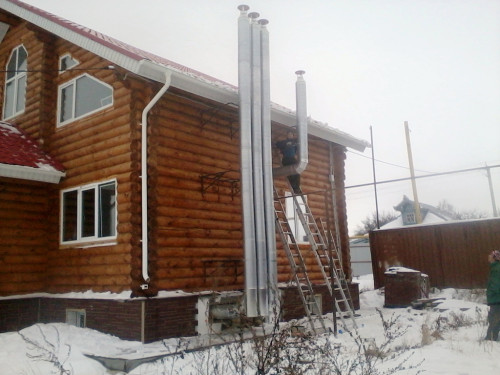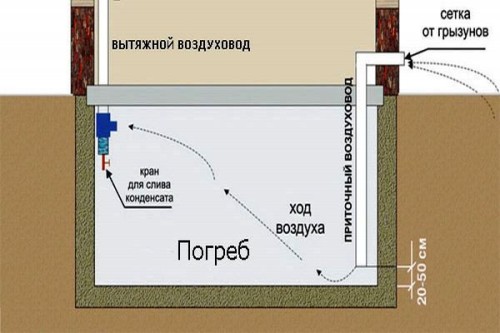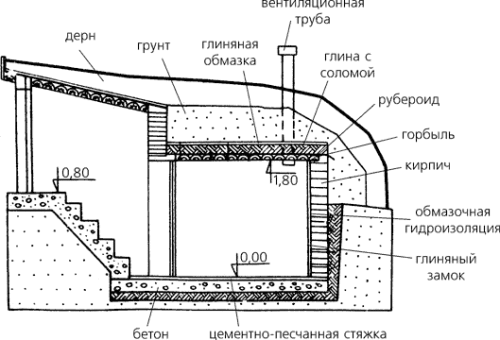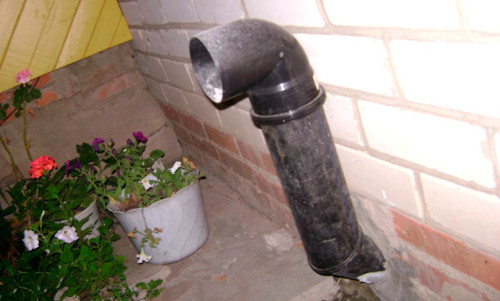In most private houses there is a basement or cellar. This is a useful room located in the underground part of the house used for storing conservation, crop and blanks. The temperature in the cellar usually does not rise too high, which ensures the long-term preservation of edible supplies. However, this requires not only suitable temperature conditions, but also a low level of humidity. Since the cellar is underground and there can be no windows in it, the humidity there is increased and the question of ventinging the room. And even if you do not plan to store food and preservation in it, ventilation is absolutely necessary. In this article, you will learn how to make ventilation in the cellar and use it as long as possible and comfortable.
Types of ventilation systems for cellar
The cellar should always be cooled, dry and dark. Only in this case can not worry about the safety of products. And if with darkness and temperature in the underground room usually do not occur, with humidity and clean fresh air will have to work. This requires ventilation in the cellar.
The use of the ventilation system in a similar room is an essential condition for its operation. A competently organized air exchange system creates a favorable atmosphere for storing food products. If the room is poorly ventilated, moisture accumulates in the air, which gradually settles on the surfaces, including on products, thereby contributing to their boot. If the ventilation, on the contrary, is too strong, excess drafts will lead to a rapid fruit drying.
In the cellar you can install one of two types of ventilation systems:
- Natural - here the main work is performed due to the heat convection, when the air heats inside the cellar rises upstairs to the ventilation opening and is displayed along the pipe out. At the same time, the freed amount is instantly filled with fresh air flows outside through another air duct.
- Forced - air movement occurs in about the same way as in the case of natural ventilation, but the speed of air exchange is significantly increased due to the supply and exhaust fans: the first suction fresh air is pulled out from the room spent. Such a system is much more effective, but requires large cash investments and maintenance costs (operating on electricity).
Whatever the system you choose, for it, the air ducts will be installed: exhaust and trim. For this purpose, galvanized, asbestos and polyvinyl chloride pipes are suitable, but the material from which they are made, but the diameter, plays paramount importance. It must be calculated, based on the area of \u200b\u200bthe ventilated room and its destination. In the case of the cellar, 26 cm² air duct area is 1 m² of room area. At the same time, the exhaust pipe is installed along one of the corners, havingto its lower cut under the most ceiling. It passes strictly vertically to the surface itself. If it is necessary to spend it through all the floors of the house and bring to the roof, the end of the exhaust pipe should rise above the skate by 50 cm. In order to reduce the amount of condensate as much as possible, which will inevitably form inside the pipe due to the temperature drop, and in the winter turn into an exhaust pipe It should be inspired. To do this, it is inserted into the air duct of the larger diameter, and the gap between them is filled with mineral wool, fiberglass, eco-art or other thermal insulating material with a thickness of 3-5 cm.
The supply pipe is mounted in the opposite corner, but not under the ceiling, and 40-60 cm from the floor level. Here it should be understood that cold air will come inside, it will gradually heat up and climb up to the exhaust hole (the main principle of operation of any ventilation system). The trim duct must be output so that its second end is 80 cm above the ground surface. It must be closed with a fine-minded grid and equip the visor from above, so that the garbage, rodents, insects or precipitates do not get inside.
Natural ventilation
Natural ventilation is the easiest and cheap way to provide a stable air exchange. The correct ventilation of the cellar contributes to the long-term preservation of the harvest and supplies. In addition to low cost such, such a system is characterized by the simplicity of installation. Installation can be done at any time, even if you have already made the finishing of the room.
Unfortunately, the natural system has one serious drawback - the air exchange stops when the temperature inside and outside becomes the same. The movement of the air masses and the displacement of warm flows is cold only in the case of the temperature difference within the cellar and on the street. For this reason, many prefer a forced type cellar ventilation device to provide a stable air exchange in the warm season when the natural system stops. In particular, it concerns spacious premises, but about it a little later.
To ensure normal ventilation, you will need to install 2 pipes: for inflow and air removal. The diameter of the air ducts should be the same so that the amount of incoming and outgoing air is equal.
Principles of ventilation devices in the cellar under the house:
- The exhaust air duct must be laid on the roof and raise over the skate. The part that will be outside, should be insulated with mineral wool and shove into a cut of a larger diameter pipe. The higher the air duct will rise, the stronger there will be an air thrust, the more effective the spent air from the basement will be removed.
- Select the pipe cross section depending on the cellar area. So, for the room at 6-8 m² you need an air duct with a diameter of 120 mm. Below is a table of sections that will help you quickly find the appropriate option.
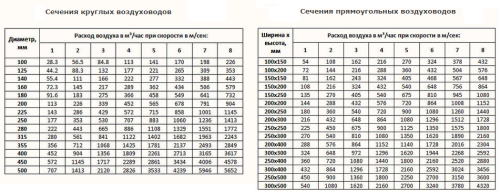
- Inside the ventilation pipes, you can install valves that will allow control the streams of air flows.
- For a small cellar, a two-channel pipe with supply and exhaust channels will be enough.
From time to time, check the effectiveness of the ventilation operation, bringing a candle to the exhaust hole and watching its flame - if it is "sucking" inside, it means good. If the flame is slightly trembling or not trembling at all, then the ventilation canal clogged. Also find out that the ventilation does not work, it is possible on a stale raw air and condensate on the surfaces.
Useful advice: If you put a small box or bag with a large salt or left lime into the cellar, the material will choose an excess moisture and disinfect air.
Forced ventilation cellar
By and large there is no fundamental difference between forced and natural ventilation. All difference in the method of excitation of air masses. If the laws of nature are in the natural system for this, the forced movement is ensured at the expense of mechanics - fans. Such ventilation under the cellar is best equipped in the construction process, but if the moment is missed, you can begin work after putting the house into operation.
When natural ventilation is not enough:
- When the room is quite large - from 40 m² and more. Natural ventilation simply will not cope with such a large amount of air, even if the air section is increased. With insufficient ventilation of a large underground storage in winter, the air will be overshadowed by moisture, which will settle on all surfaces and the inner walls of the air ducts. Gradually, condensate will accumulate and with the onset of cold, it will be covered, which will lead to a complete stop of the air movement. Working fans eliminate this problem, not allowing condensate to accumulate. The exception is only those cases when the basement is divided into several rooms. Then in each of them can be made on their own natural ventilation.
- If you are going to make a living room in the basement, living room, bar, cinema, etc. The room in which people will be constantly working, requires a more powerful air exchange than an ordinary cellar where vegetables are stored. Moreover, if a gym is planned to do in the basement, the ventilation power must be done even higher, since the consumption of fresh air at intensive loads increases. The table below shows the approximate calculation of the air exchange for various rooms.

- If a large number of edible supplies are stored in the cellar, good powerful fans are needed for their ventilation, so that the extractor has coping not only with the removal of excess moisture from the air, but also with odors.
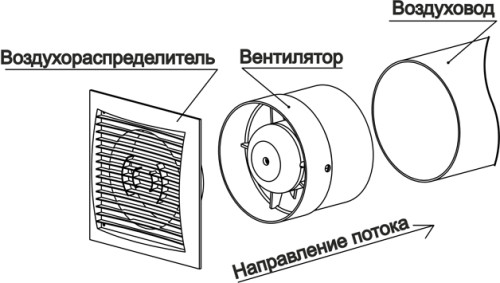
The scheme of forced ventilation in the cellar resembles a natural system, only an exception that in addition to air ducts it is necessary to mount special fans. The power of these fans directly affects the efficiency of the entire structure, so before buying them, you need to make calculations. The usual cellar has too powerful fans. They will use only if you are planning to make a living room, but according to experts, it is better to use split systems or air conditioners to ensure a comfortable climate.
Air ducts forced ventilation can be positioned vertically and horizontally - with proper installation, this does not affect the operation of the system. The situation depends on the design features and location of the cellar in the house. In the already built houses, the pipes most often put horizontally, since there is no other way out. To properly organize the work of the drawing, it is recommended to establish a diffuser that will reduce the cost of electricity using the energy from the wind strength. It is assembled at the end of the air duct, derived to the street. Of course, if the wind is not, the system will have to work from the mains, but in any case an alternative power source will allow a little to save on maintenance.
So how to make ventilation in the cellar? Depending on the area and the future of its use, you can set 1 or 2 fans. In the first case, the fan is mounted in the exhaust air duct from the cellar so that the exhaust air is pulled out. In the process of work in the room there will be a relative vacuum, which will contribute to the influx of fresh air through the trim duct.
If the room is large, one fan will not be enough. It will be necessary to equip and exhaust, and the supply pipe to faster the air into the room faster. It should take into account that the basement always reigns relatively high humidity, therefore with electrical equipment should be neat. Choose mechanisms designed for 36 V and transformers to them. If you neglect by this rule, sooner or later, interruptions will begin to appear on the network, which can lead to a short circuit and fire.
Of course, such a system can only work from electricity, the cost of which in the private sector is often very high. That is why for savings, many are resorted to the use of deflectors. Special caps - nozzles are attached to the exhaust pipe, and when the wind blows in them, redundant pressure is formed. Some instead of deflectors use miniature windmills. Such turbines are installed on the top of the pipe, and they like the floods catch the wind streams, passing them through a flexible shaft or gearbox to the fans installed inside the pipe.
In each of these cases, the speed of movement of air masses can be adjusted. However, even if you decide to install forced ventilation, it is not necessary to completely exclude the possibility of the functioning of the natural system. For this, the ventilation channels must be established with all the above requirements (location height, cross section, etc.). Mixed systems are most popular because they save electricity at any convenient case. Ventilation of the cellar is your own hands - this is a time-consuming, but absolutely necessary work, without which the comfortable use of the room is simply impossible.



